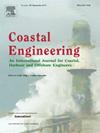Assessing the role of a probabilistic model for guiding storm surge barrier maintenance
IF 4.5
2区 工程技术
Q1 ENGINEERING, CIVIL
引用次数: 0
Abstract
Storm surge barriers provide flood protection to many major coastal cities in estuaries around the world. Maintenance of these assets is critical to ensure they remain reliable and continue to comply with national legal protection standards. There are often critical thresholds of environmental conditions, beyond which maintenance work is unsafe to be carried out. However, as storm surge barriers age and with climate change effects such as sea-level rise and possible changes in storminess, periods when environmental conditions exceed set thresholds will occur more frequently, so carrying out the required work in available maintenance windows will become increasingly challenging. Probabilistic models enable the use of ensemble forecasts of upcoming water levels to determine the likelihood of conditions exceeding the threshold and so can inform on decision making regarding maintenance. This paper evaluates a probabilistic model currently in operational use by Rijkswaterstaat, the Dutch Ministry of Infrastructure and Water Management, to guide maintenance decisions at the Maeslant barrier in the Netherlands. Sixteen years of historic highwater level forecasts from a combination of European Centre for Medium-Range Weather Forecasts and Dutch Continental Shelf Model v5 are used with observations from the Hoek van Holland tide gauge to evaluate and sensitivity test the probabilistic model. Binary classification is used to assess the performance of the probabilistic model. Findings show that the model is conservative with 33.1 % of outcomes resulting in a False Alarm. Changing the baseline parameters of critical probability and water level threshold impacts the balance between False Alarm and Miss outcomes. Increasing the critical probability reduces the number of False Alarms but increases the Miss situations, emphasising the trade-off between acceptable risk and time available to carry out maintenance work. This study highlights the delicate balance between model parameter selection and the associated risk with respect to the maintenance of storm surge barriers.
评估指导风暴潮屏障维护的概率模型的作用
风暴潮屏障为世界各地河口的许多主要沿海城市提供洪水保护。维护这些资产对于确保它们保持可靠并继续遵守国家法律保护标准至关重要。通常存在环境条件的临界阈值,超过该阈值进行维护工作是不安全的。然而,随着风暴潮屏障的老化和气候变化的影响,如海平面上升和风暴的可能变化,环境条件超过设定阈值的时期将更频繁地发生,因此在可用的维护窗口进行所需的工作将变得越来越具有挑战性。概率模型可以使用即将到来的水位的综合预测来确定超过阈值的可能性,从而可以为有关维护的决策提供信息。本文评估了荷兰基础设施和水资源管理部Rijkswaterstaat目前正在使用的概率模型,以指导荷兰Maeslant屏障的维护决策。利用欧洲中期天气预报中心和荷兰大陆架模式v5所提供的16年历史高水位预报资料,结合Hoek van Holland潮汐计的观测资料,对概率模型进行评估和灵敏度测试。二值分类用于评估概率模型的性能。结果表明,该模型是保守的,33.1%的结果导致假警报。改变临界概率和水位阈值的基线参数会影响虚警和漏警结果之间的平衡。增加临界概率减少了误报的数量,但增加了误报的情况,强调了可接受的风险和执行维护工作的可用时间之间的权衡。这项研究强调了模型参数选择与风暴潮屏障维护相关风险之间的微妙平衡。
本文章由计算机程序翻译,如有差异,请以英文原文为准。
求助全文
约1分钟内获得全文
求助全文
来源期刊

Coastal Engineering
工程技术-工程:大洋
CiteScore
9.20
自引率
13.60%
发文量
0
审稿时长
3.5 months
期刊介绍:
Coastal Engineering is an international medium for coastal engineers and scientists. Combining practical applications with modern technological and scientific approaches, such as mathematical and numerical modelling, laboratory and field observations and experiments, it publishes fundamental studies as well as case studies on the following aspects of coastal, harbour and offshore engineering: waves, currents and sediment transport; coastal, estuarine and offshore morphology; technical and functional design of coastal and harbour structures; morphological and environmental impact of coastal, harbour and offshore structures.
 求助内容:
求助内容: 应助结果提醒方式:
应助结果提醒方式:


